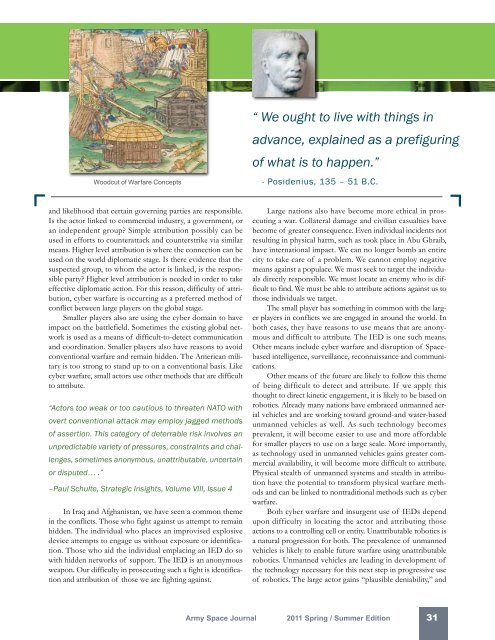Spring 2011 - Space and Missile Defense Command - U.S. Army
Spring 2011 - Space and Missile Defense Command - U.S. Army
Spring 2011 - Space and Missile Defense Command - U.S. Army
Create successful ePaper yourself
Turn your PDF publications into a flip-book with our unique Google optimized e-Paper software.
Woodcut of Warfare Concepts<br />
“ We ought to live with things in<br />
advance, explained as a prefiguring<br />
of what is to happen.”<br />
- Posidenius, 135 – 51 B.C.<br />
<strong>and</strong> likelihood that certain governing parties are responsible.<br />
Is the actor linked to commercial industry, a government, or<br />
an independent group? Simple attribution possibly can be<br />
used in efforts to counterattack <strong>and</strong> counterstrike via similar<br />
means. Higher level attribution is where the connection can be<br />
used on the world diplomatic stage. Is there evidence that the<br />
suspected group, to whom the actor is linked, is the responsible<br />
party? Higher level attribution is needed in order to take<br />
effective diplomatic action. For this reason, difficulty of attribution,<br />
cyber warfare is occurring as a preferred method of<br />
conflict between large players on the global stage.<br />
Smaller players also are using the cyber domain to have<br />
impact on the battlefield. Sometimes the existing global network<br />
is used as a means of difficult-to-detect communication<br />
<strong>and</strong> coordination. Smaller players also have reasons to avoid<br />
conventional warfare <strong>and</strong> remain hidden. The American military<br />
is too strong to st<strong>and</strong> up to on a conventional basis. Like<br />
cyber warfare, small actors use other methods that are difficult<br />
to attribute.<br />
“Actors too weak or too cautious to threaten NATO with<br />
overt conventional attack may employ jagged methods<br />
of assertion. This category of deterrable risk involves an<br />
unpredictable variety of pressures, constraints <strong>and</strong> challenges,<br />
sometimes anonymous, unattributable, uncertain<br />
or disputed… .”<br />
–Paul Schulte, Strategic Insights, Volume VIII, Issue 4<br />
In Iraq <strong>and</strong> Afghanistan, we have seen a common theme<br />
in the conflicts. Those who fight against us attempt to remain<br />
hidden. The individual who places an improvised explosive<br />
device attempts to engage us without exposure or identification.<br />
Those who aid the individual emplacing an IED do so<br />
with hidden networks of support. The IED is an anonymous<br />
weapon. Our difficulty in prosecuting such a fight is identification<br />
<strong>and</strong> attribution of those we are fighting against.<br />
Large nations also have become more ethical in prosecuting<br />
a war. Collateral damage <strong>and</strong> civilian casualties have<br />
become of greater consequence. Even individual incidents not<br />
resulting in physical harm, such as took place in Abu Ghraib,<br />
have international impact. We can no longer bomb an entire<br />
city to take care of a problem. We cannot employ negative<br />
means against a populace. We must seek to target the individuals<br />
directly responsible. We must locate an enemy who is difficult<br />
to find. We must be able to attribute actions against us to<br />
those individuals we target.<br />
The small player has something in common with the larger<br />
players in conflicts we are engaged in around the world. In<br />
both cases, they have reasons to use means that are anonymous<br />
<strong>and</strong> difficult to attribute. The IED is one such means.<br />
Other means include cyber warfare <strong>and</strong> disruption of <strong>Space</strong>based<br />
intelligence, surveillance, reconnaissance <strong>and</strong> communications.<br />
Other means of the future are likely to follow this theme<br />
of being difficult to detect <strong>and</strong> attribute. If we apply this<br />
thought to direct kinetic engagement, it is likely to be based on<br />
robotics. Already many nations have embraced unmanned aerial<br />
vehicles <strong>and</strong> are working toward ground-<strong>and</strong> water-based<br />
unmanned vehicles as well. As such technology becomes<br />
prevalent, it will become easier to use <strong>and</strong> more affordable<br />
for smaller players to use on a large scale. More importantly,<br />
as technology used in unmanned vehicles gains greater commercial<br />
availability, it will become more difficult to attribute.<br />
Physical stealth of unmanned systems <strong>and</strong> stealth in attribution<br />
have the potential to transform physical warfare methods<br />
<strong>and</strong> can be linked to nontraditional methods such as cyber<br />
warfare.<br />
Both cyber warfare <strong>and</strong> insurgent use of IEDs depend<br />
upon difficulty in locating the actor <strong>and</strong> attributing those<br />
actions to a controlling cell or entity. Unattributable robotics is<br />
a natural progression for both. The prevalence of unmanned<br />
vehicles is likely to enable future warfare using unattributable<br />
robotics. Unmanned vehicles are leading in development of<br />
the technology necessary for this next step in progressive use<br />
of robotics. The large actor gains “plausible deniability,” <strong>and</strong><br />
<strong>Army</strong> <strong>Space</strong> Journal <strong>2011</strong> <strong>Spring</strong> / Summer Edition 31
















